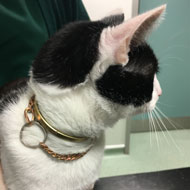
Owners warned not to put jewellery on animals
Pet owners are being urged not to ‘decorate’ their animals with jewellery, after veterinary staff in Birmingham had to anaesthetise a cat to cut off a bangle that had been placed around her neck.
RSPCA inspector Herchy Boal was paying a visit to a property in Solihull last month, when she noticed 11-month-old cat CC had a metal bangle around her neck.
“The owner admitted to me that he’d put the metal bangle around her neck when she was a kitten as he thought it was pretty,” inspector Boal said.
However, as CC grew the band had become tighter and tighter until it could not be removed, and in time, it would have begun to cut into her flesh.
The young cat was taken to the charity’s Newbrook Farm Animal Hospital in Birmingham, where she was anaesthetised so vets could cut the bangle off. She was then neutered and microchipped, before being returned to her owner.
Inspector Boal added: “I spoke to CC’s owner and he soon realised what a silly thing it was to do and was very apologetic for the error in judgement.”
The RSPCA is urging owners not to dress their pets up in accessories or jewellery, as they could cut into their skin and cause injury. There is also a risk that a bangle, such as the one found on CC, could be lethal if it got hooked on something.
Cat welfare expert Alice Potter said: “Sadly, we see all too often cats with awful injuries caused by dangerous collars which is why we advise against using those that aren’t quick-release, or leaving flea collars on your pets.
“Cats are natural hunters and curious explorers that enjoy climbing trees or pushing through tight spots and for these reasons it is imperative that any collar is designed to free should they become snagged during their adventures.
“If the collar gets caught on something the cat may try to free itself by using its foot and then, in turn, gets its leg stuck with the collar ending up under the cat’s armpit causing painful injury.
“Poor CC could have ended up with an awful injury thanks to this metal bangle or, in the worse case scenario, could even have been killed if she’d have got it caught on something.”
Image © RSPCA



 The RCVS has announced a new version of its 1CPD mobile app, with enhanced features for veterinary surgeons and veterinary nurses to record their continuing professional development.
The RCVS has announced a new version of its 1CPD mobile app, with enhanced features for veterinary surgeons and veterinary nurses to record their continuing professional development.